FIT AG: Laying the foundations for high-volume metal Additive Manufacturing
There is no doubt that the Additive Manufacturing of series components is quickly becoming a reality. From high-profile applications in the aerospace industry to performance components for the automotive sector, there are now numerous examples of the successful implementation of metal AM. However, the route that a company chooses in order to adopt AM technology could have a significant impact on a component’s development time and cost. As Nick Williams reports, Germany’s FIT AG sees opportunities in leveraging its expertise to supporting companies with the outsourcing of component development and production. To achieve this, the company has created a model AM factory that it plans to replicate worldwide. [First published in Metal AM Vol. 2 No. 3, Autumn 2016 | 20 minute read | View on Issuu | Download PDF]
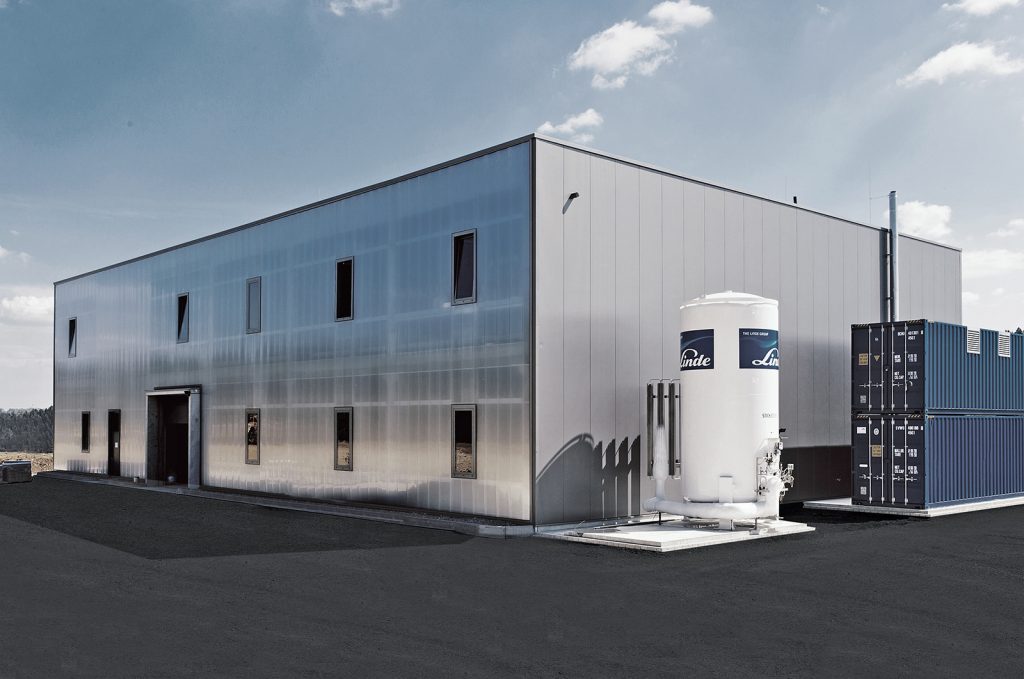
FIT Group, based in Lupburg, Germany, has ambitious plans for metal Additive Manufacturing. The company is one of the world’s most experienced in the development and production of AM components thanks in large part to its early involvement in rapid prototyping. It is, however, approaching the goal of creating a state-of-the-art factory for higher volume series metal Additive Manufacturing with an energy and ambition that would put even the most motivated of start-ups to shame.
The force behind the company is its founder and CEO, Carl Fruth. His no-nonsense approach to the industry and his vision for the metal AM factory concept is based on more than twenty years of experience in additive technologies. This experience is balanced with the recognition that metal Additive Manufacturing has to develop into a far more stable, automated and cost-effective process if it is to succeed in series production. Whilst this may sound like an obvious approach, the reality of developing a viable state-of-the-art factory for series metal AM component production is far from straightforward.
The story to-date
In the summer of 2015 FIT AG announced that it was investing €20 million in a new purpose built factory specifically designed for the Additive Manufacturing of high volume components. A year later, when Metal Additive Manufacturing magazine visited the company, construction of the first of the new futuristic looking production buildings had been completed and the manufacture of metal and plastic parts was underway (Figs. 1-3).
Reaching this point has in itself been a long journey for the company. Founded in 1995, FIT was a pioneer in the world of commercial rapid prototyping using both metals and plastics. The company started researching paper lamination technology in 1997, followed a year later with trials of Selective Laser Sintering (SLS) technology. By 2003 the company was producing laser sintered rapid tooling for customers and in 2005 the first Electron Beam Melting (EBM) system was in operation for the production of titanium components. Production capacity continued to expand and in 2013 the world’s first four-laser machines, SLM Solutions’ SLM 500s, were installed. Within a year this had been expanded to seven SLM Solutions machines, including three large frame SLM 500s.
As the business grew so did FIT’s expertise in developing the necessary software for AM, culminating in the formation of Netfabb GmbH in 2009. Netfabb’s software became one of the most used AM design and manufacturing tools and its success resulted in the acquisition of Netfabb by Autodesk in 2015. FIT’s unrivalled reputation in the field of AM software development is further reflected in the company’s status as a founding member of the 3MF Consortium alongside international corporations such as GE, HP and Microsoft. The consortium is committed to defining and evolving a 3D printing file format that allows designers to send full-fidelity 3D models between multiple platforms and manufacturing equipment.
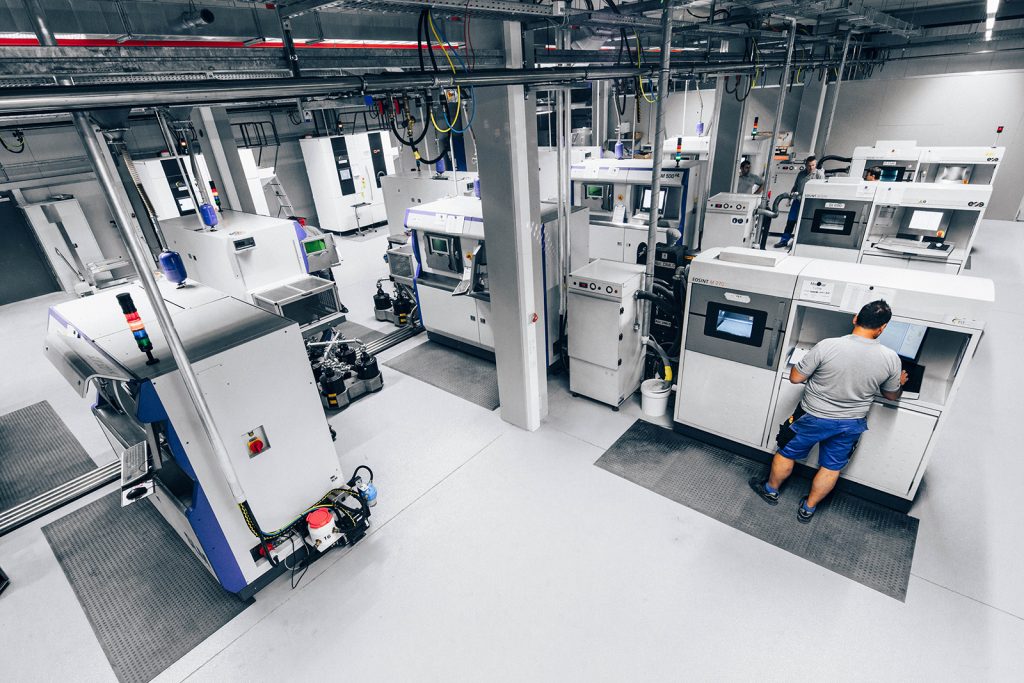
At the same time as the acquisition of Netfabb, Autodesk made a strategic investment in FIT AG, acquiring 10% of the company. This development was a natural fit for two businesses that share a vested interest in the increased adoption of AM technology for industrial-scale manufacturing. The investment also provided capital to support Fruth’s ambition of creating a state-of-the-art Additive Manufacturing factory.
Today FIT has more than 220 employees, with most of them located at the company’s headquarters in Lupburg. The company operates two distinct businesses, FIT Prototyping GmbH and FIT Production GmbH. The group has two further subsidiaries, FIT Nord GmbH near Hamburg, and FIT West Corporation in Boston, Massachusetts, USA. Turnover in 2015 was €17 million, representing an increase of 30% on the previous year.
The business is centred around three main segments; Prototyping, Additive Design and Manufacturing (ADM) and Research and Development. The AM factory concept fits most closely within the ADM segment that specialises in additive engineering as well as high and low volume AM component manufacturing. The Prototyping segment has specific expertise in concept models and functional prototypes, however pre-production runs are also accommodated. The R&D segment specifically addresses system, process and materials development.
Creating a metal AM factory template
FIT’s primary mission with its facility in Lupburg is the optimisation of a high production volume AM factory template that can be rolled out at other sites around the world. “This factory will serve as a master concept for commissioning industrial Additive Manufacturing close to our customers. By copying the entire production process of an efficiently operating Additive Design and Manufacturing plant, manufacturing costs will be reduced and quality of the parts improved,” Fruth told Metal AM magazine.
This concept is based on the belief that whilst ever more end-users will recognise AM as a technology that can revolutionise their business, they will chose to collaborate on component development and then outsource production rather than creating their own in-house metal AM facility. Outsourcing could, at the simplest level, involve placing orders for parts to be optimised and manufactured in Lupburg or a future FIT manufacturing site. On a larger scale, a manufacturer could enter an agreement to establish a dedicated metal AM facility near a customer’s site using FIT’s factory template.
One of the attractions of this route for a company looking to take advantage of metal AM is that it significantly decreases process and component development time. Given that AM requires a completely different approach to conventional manufacturing methods, this can be a significant advantage.
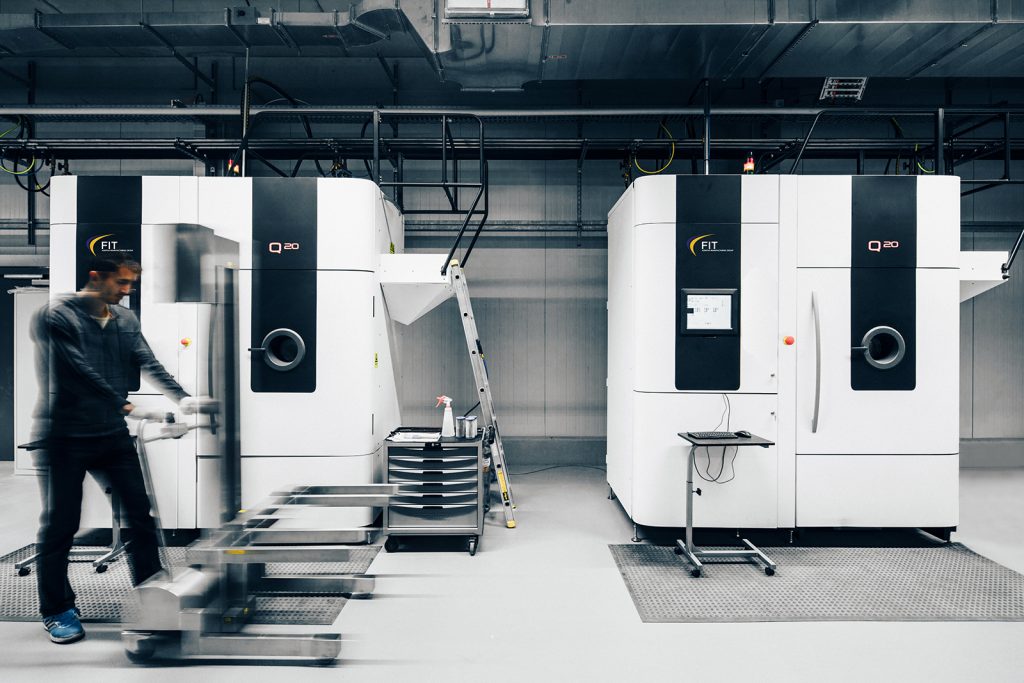
Fruth explained that, in terms of part design alone, the knowledge that an engineer has to possess in order to successfully produce parts by Additive Manufacturing differs fundamentally from conventional manufacturing methods. When the unique challenges of AM production are added, for example system and process stability, materials expertise, materials recycling, post-processing, quality assurance and traceability, the task can appear overwhelming. “People think that metal AM is easy to implement. You have the design freedom, you have a machine that can build complex parts and you believe that the product comes straight out of this system at the end. This just isn’t the case. At FIT our goal is to support you in harnessing the power of Additive Design and Manufacturing.”
Fruth added, “There is a belief that to benefit from metal AM you have to set up your own metal AM facility and at the heart of this people see AM machines. But machines are simply machines: they are not the be all and end all. AM machines are just part of a wider process that has to be developed and evolved. Digital manufacturing is disruptive but it is also highly complex. On top of this, the technology is looking to replace processes that in some cases have been refined over many hundreds of years. Put it this way, if you need investment cast parts you probably won’t go straight out and buy an investment casting plant. So why buy an AM machine when you can work with us to design, develop and then manufacture your products?”
There is clearly a demand for the company’s expertise and to keep up with orders FIT has doubled its production capacity in the last twelve months. Installed equipment within the new facility in Lupburg now includes eighteen Selective Laser Melting machines for aluminium and superalloy parts production. These consist of fifteen SLM Solutions machines plus three EOS machines. This brings the number of lasers, a clearer indicator of production capacity, to sixty. In addition, the facility has four Arcam EBM machines for titanium production. A number of additional machines are on order to be installed within the next twelve months.
Fruth explained that as the factory concept evolved it became clear that the flexibility of the open source nature of the machines from SLM Solutions and Arcam was essential for the company. “Developing a metal AM factory demands the customisation and specialist configuration of AM machines, both in terms of hardware and software. Open source machines win here for us” (Fig. 4).
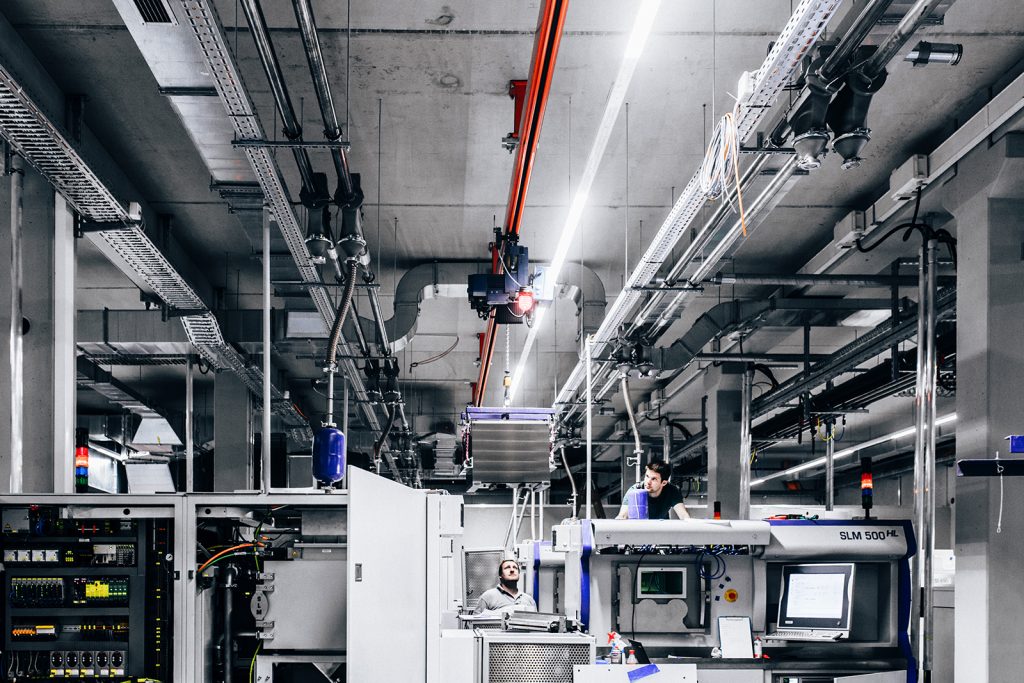
He cautioned, however, about underestimating the wider requirements of a metal AM factory. Machines are an important aspect of the process but they have to be fully integrated into a purpose built, modular and automated AM factory. Customisation and the development of in-house solutions does not therefore stop with the production machines. In addition to sophisticated data networks to monitor and record all operations in the factory, the network concept has been taken a step further when it comes to the handling of metal powders. Metal powder delivery is continuous and fully automated using a network of overhead pipes that feed powder from a central source to each production machine. All materials run in separated pipe feeds under over-pressure to avoid contamination. Manual feeds are only used on a laboratory and prototyping level. The company has also developed its own powder sieving systems to maintain the consistent powder properties that are essential to successful high volume production.
A number of heat treatment operations such as T6 are carried out in-house, however Hot Isostatic Pressing (HIP) operations are outsourced. Fruth stated, “HIP is still done externally as it is unclear for today if this technology will still be needed in 2020. As soon we know about this we are going to decide if this is a useful investment.”
Workflow planning
The secret to high volume AM production, stated Fruth, lies in detailed and sophisticated workflow planning, but he cautioned that it is only with experience of volume production that workflows can be fully understood and refined.
Whilst we were standing outside FIT’s new AM factory building, Fruth pointed to a McDonalds restaurant sign on the horizon and pressed home the point that just as a fast-food chain can only succeed when process and supply chain are fully optimised, an industrial scale AM operation also has to have every aspect of its workflow and supply chain in place. “The beauty of McDonalds, of course, is that the business has unlimited scalability. You can also go into any restaurant in the world and because the workflows and supply chain are so sophisticated, you will always get exactly what you expect. This is our mission for metal AM, process and supply chain in harmony, with unlimited scalability.”
Reducing costs
With scale and workflow optimisation comes the opportunity to reduce costs and Fruth states that prices will come down significantly in the next five years. The cost of metal AM products will be reduced through a combination of scrap reduction, increased output per machine thanks to faster processing, a reduction in raw material costs and a reduction in the number of operators required per machine. There are, of course, numerous other factors that will also play a role in increasing the efficiency of an industrial-scale process.
Fruth anticipates that with part design, workflow and machine improvements the cost of metal AM parts will drop from a current price of around €3.00 per g for aluminium, titanium and stainless steel alloys to €2.00 in 2017 and €1.00 by 2020.
Getting into the mind-set for the metal AM revolution
Fruth believes that the majority of potential end-users simply are not prepared for digital manufacturing because they have not understood the broadest concepts of how the technology will change manufacturing. “Manufacturing is today based on the traditional linear optimised assembly lines with clearly defined zones, but digital manufacturing and the Industry 4.0 concept turns this on its head.”
The challenge is, therefore, far more fundamental than trying to educate designers about the requirements and possibilities of AM. Fruth stated that it is essential that the integration of digital manufacturing into a business happens on multiple levels, with the boardroom being the driving force. “Such a fundamental shift in attitudes needs to be driven at a board level. We talk to engineers a great deal about metal AM, but the reality is that they cannot facilitate change. We also have to be talking at management and board level.”
Managing change is a challenge in any organisation, but the aversion to change increases significantly the larger a company is. “There is a natural resistance to change at all levels. The fear of re-qualifying parts, the fear of change that may result in the elimination of your job and the fear of moving from processes that you understand to processes that you do not are just some examples of the effects that such a shift can have in an organisation. It will of course be a bigger challenge for larger companies to make the move to using AM than for operators with less baggage.”
Designing for AM is understood by those with knowledge of the technology as being of fundamental importance. It is, however, a message that is still failing to reach many in industry. “Coming to us with an existing part that you just want to make by AM will never work. In order for AM to succeed a part has to be designed for the process and this takes experience and knowledge. There also has to be a reason to use AM, be it advanced functionality, the need for customisation or certain production volumes. We can help with this, but anything else will simply make no financial sense.”
Unrealistic expectations are, however, not limited to design considerations. “Companies have to learn to understand the nature of the process. When we are making a single component for a customer they have to appreciate, for example, that a build plate is shared with other components from other companies and they have to understand that in AM powder has to be recycled. This is a part of the process and needs to be more widely understood.”
ADM solutions tailored to specific requirements
During the evaluation of a component for AM at FIT a number of criteria are considered to establish which of the company’s ADM programmes the part most closely relates to. For single or limited part production the ADM-Quality (ADM-Q) programme focuses on the development of a component to a level where it can be manufactured to specification and within a fixed budget. Quality certificates accompany the part in line with the respective part’s requirements.
Whilst the quality of single parts and small batch series is assured by the ADM-Q programme, ADM Volume Manufacturing (ADM-V) focuses on establishing a thorough and consistent process control for larger series production. A full audit trail of every job, part variations and the tracking of material batches is, states the company, the foundation for ADM-V to meet the necessary level of quality control. In addition, parts for higher volume production are subjected to a far more intensive process of design optimisation with the evaluation and testing of a number of design variants where necessary.
Whilst ADM-V development takes longer than for an ADM-Q component, the results typically include reduced final component weight and, of course, significantly reduced unit costs. As an extension of ADM-V, customised volume manufacturing enables the efficient production of a large number of individualised single parts in one production cycle to achieve genuine mass customisation.
Quality management at FIT
The quality requirements of metal AM parts are application and market specific and as such FIT is ISO 9001 and EN 9100 certified (the European equivalent of AS 9100 for aerospace) and the company’s medical devices and implants are FDA compliant and fulfil the requirements of the EN ISO 13485. The company is also certified to the automotive industry supply chain standard ISO/TS16949.
Traceability is offered at all stages of AM part production, from the starting powder to testing of the final product. The company has also recently confirmed the purchase of a CT scanner that will provide customers with certification that their critical components do not contain defects such as cracks or voids.
Fruth stated that a realistic approach to metal AM needed to be taken from a quality assurance perspective. “The aerospace industry was an early adopter of AM technology and new applications in this sector attract considerable attention. This is the sector, however, that demands the highest levels of quality assurance because of the critical nature of the components used. This puts a lot of pressure on a young technology. It has to be remembered that all parts fail at the highest level and such extreme levels of quality assurance come at a very high price. Growth for the industry will therefore come from more mainstream applications where the quality assurance and qualification requirements are less cost-prohibitive.”
Markets
FIT’s most important markets for its Additive Design and Manufacturing business are motorsport, medical, defence, aerospace and advanced engineering. Motorsport has long been an adopter of AM technologies as the process can achieve the highest requirements in terms of component performance and flexibility. The technology can also offer very short development times. By applying Additive Design and Manufacturing to a prototype F1 cylinder head, FIT used Selective Laser Melting to significantly increase surface cooling area while achieving reduced vibration and part weight (Fig. 10).
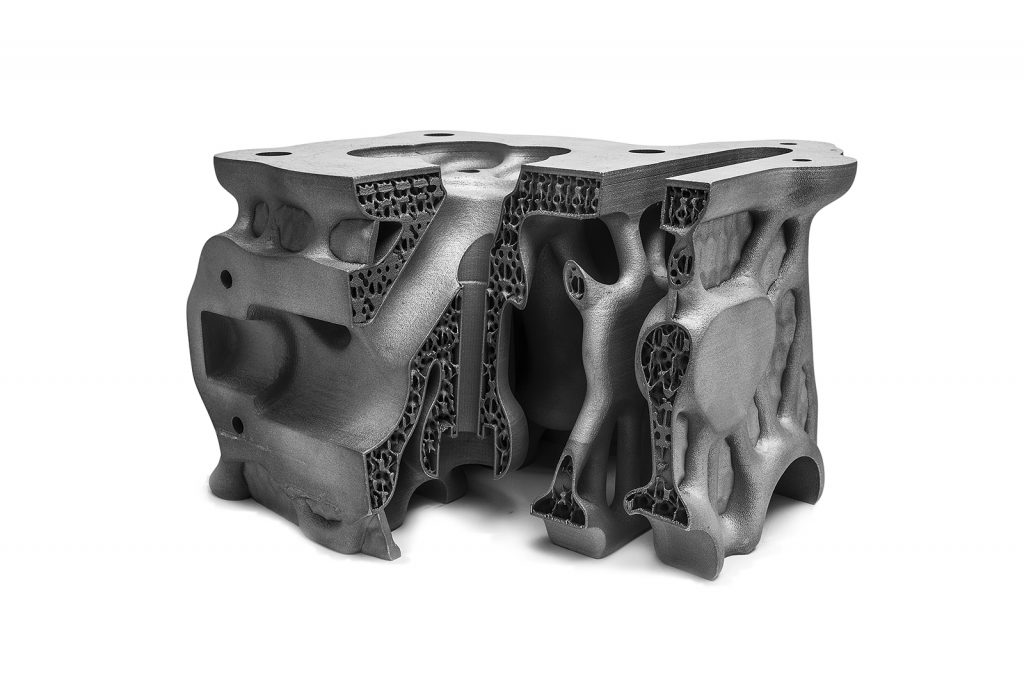
The metal AM industry has also enjoyed considerable success with the production of medical implants and FIT specialises in the manufacture of implants made from Grade 2 and Grade 5 titanium alloys by Electron Beam Melting (Figs. 11 and 12). These bone replacing implants are used when a section of bone is missing and the gap needs to be filled, for example following an accident or after the removal of a tumour. AM’s main advantages lie in the extremely short lead times that average one to two weeks instead of six to eight weeks by conventional technology. AM can also generate a rough and deliberately porous surface that allows for improved bone ingrowth, or osseointegration, helping to avoid common problems such as loose and unstable implants and to shorten rehabilitation time. With AM, of course, implants are produced to a size and shape specifically to meet a patient’s requirements.
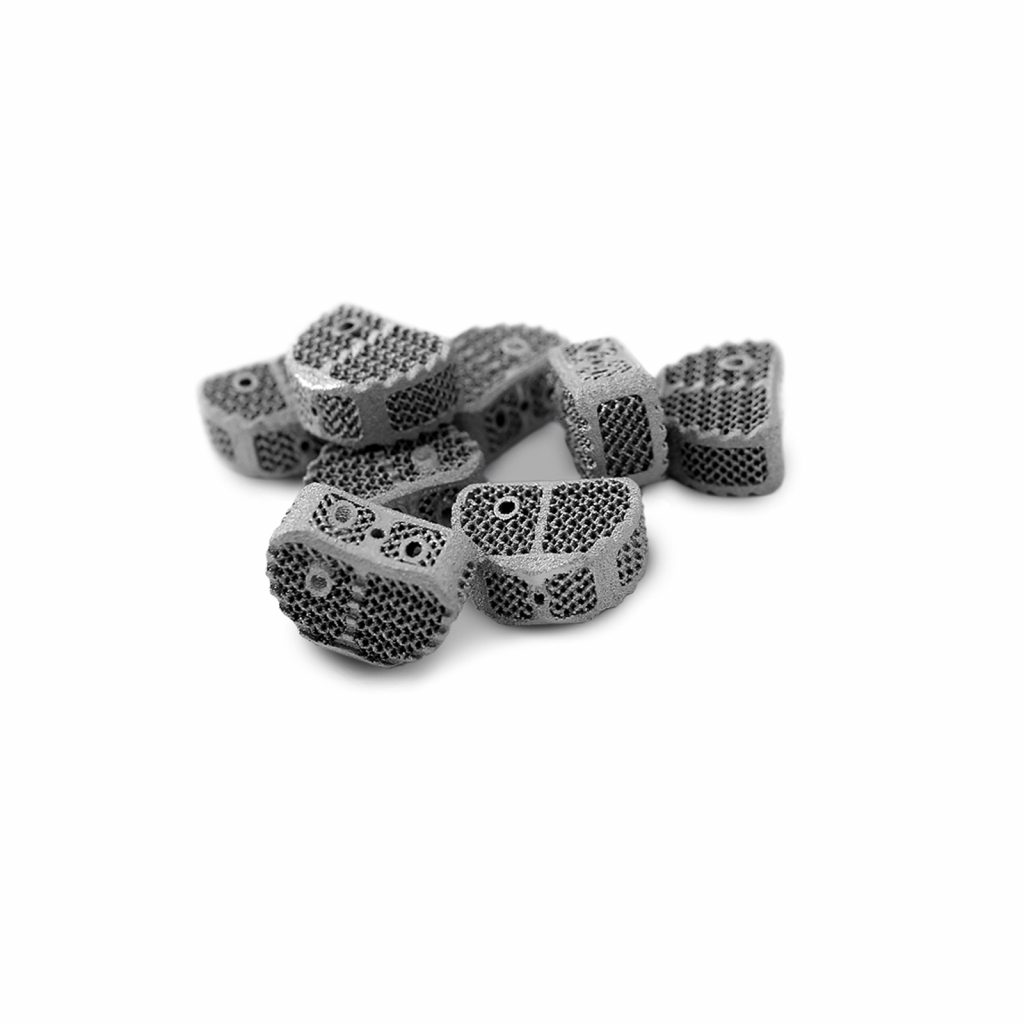
In terms of the wider markets for metal AM, design innovations at OEMs will, believes FIT, lead to a much wider adoption of the technology, particularly when combined with a fundamental shift in the approach to manufacturing. In order to facilitate this the company offers “Additive Design and Manufacturing” workshops that cover all aspects of the component development and production process.
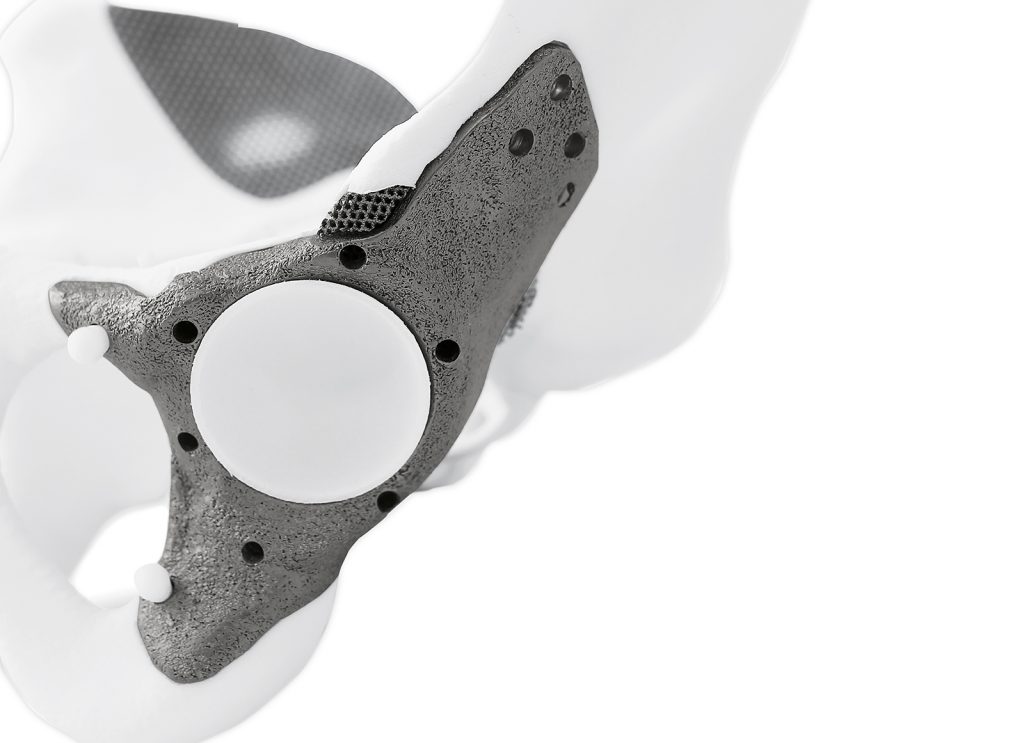
Innovation: People: training and education
Those studying for engineering related degrees at university generally recognise Additive Manufacturing as a high profile and attractive industry from a career perspective. There are, however, widespread concerns in the industry about the number of people with the necessary skillsets to sustain growth. FIT’s workforce is continually expanding as the company grows and, to help meet the challenge of securing a skilled workforce, the company runs a number of highly sought-after apprenticeships. In September this year eighteen apprentices started their training at FIT, a record number for the company. These apprenticeships cover all aspects of AM including process mechanics, mechatronics, modelling, product design and IT.
“Access to capable young talent is very important to us. Our trainees learn in a very high-tech industry and contribute from the outset to growth of the company. Again and again they are also among the best of their peers. We are very proud of what we achieve with these apprenticeships,” stated Lorenz Barth, Personnel Manager at the FIT AG. The company employs a high proportion of women, at around 40%, and it has made efforts to successfully integrate disabled workers into the business.
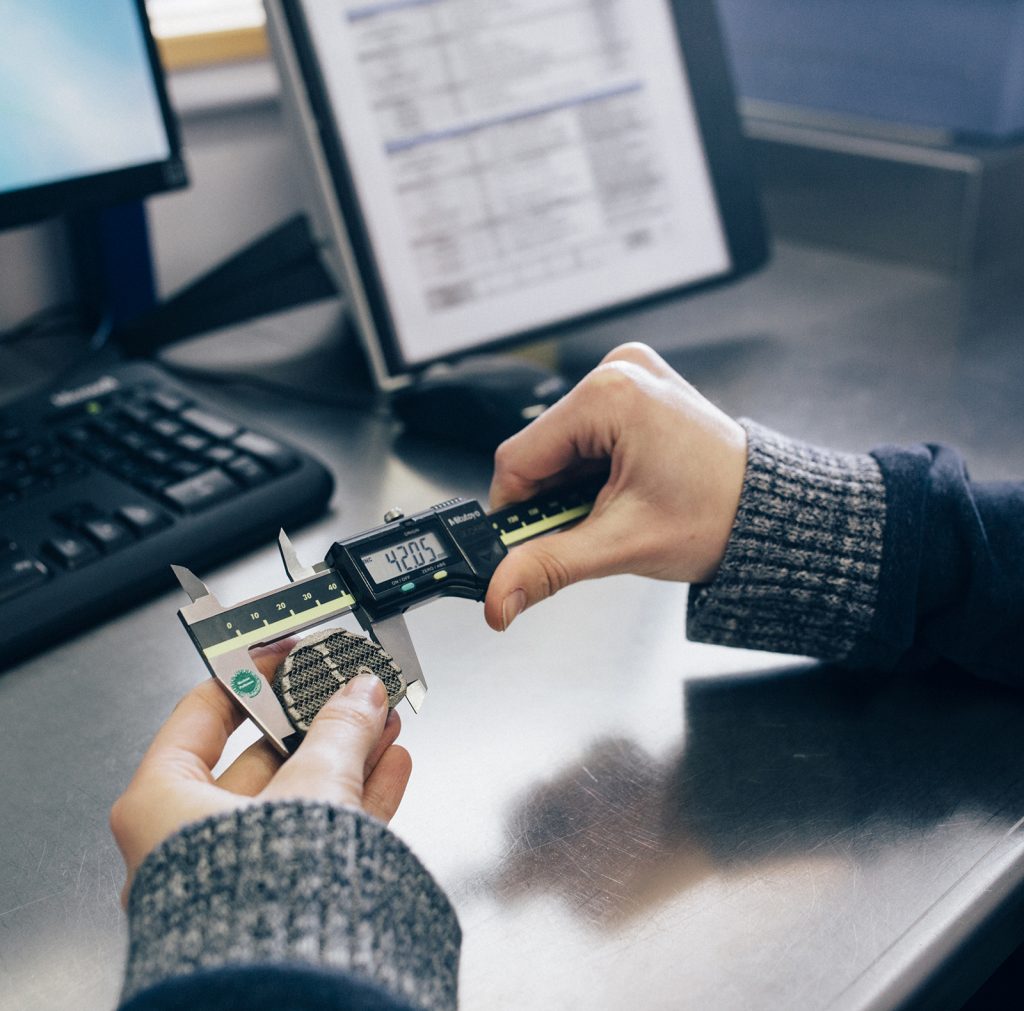
Outlook
Given the rapid pace of metal AM’s growth it is impossible to predict with any certainty how trends in part manufacture will play out. For the major aerospace manufacturers there will always be the funds and skills available to develop systems and workflows in-house whilst additionally retaining a level of technology independence and security in terms of production capacity. There will, however, also be companies that have the desire to take advantage of all that metal AM can offer for series part production whilst working with an experienced industrial partner to facilitate this.
FIT’s commitment to the development of a model production facility dedicated to higher volume AM part production has without doubt put it in a leading position to be able to capitalise on the rapidly increasing demand for metal AM parts. “We believe this is what qualifies us as the industrial partner to implement new manufacturing concepts with customers worldwide,” stated Fruth. He cautioned, however, that the technology still has a long way to go in terms of industrialisation. “We only know 5% of what there is to know about commercial AM production. The industry has only touched on the surface of the challenge and potential of metal AM.”
Contact
Elisabeth Bauer
FIT AG
Eichenbühl 10
92331 Lupburg
Germany
Phone: +49 (0) 9492 9429 0
Fax: +49 (0) 9492 9429 11
Email: [email protected]
www.pro-fit.de







